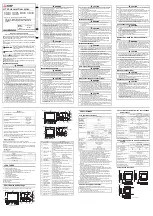
Setting the DIP Switches
Setting the Minimum Impedance The Amplifier Can Safely Drive
Setting the IMPEDANCE DIP switches enables the RVL-6 to constantly monitor which pairs of speakers are playing
and select the minimum impedance the amplifier can safely drive. This feature not only protects the amplifier, but
optimizes the amount of power delivered to each speaker.
Setting the AMP DIP Switches
• The AMP DIP switches identify the minimum impedance an amplifier can safely drive (see
Figure 17
).
• The amplifier must be capable of safely driving a 4 Ohm load.
Setting the SPEAKER DIP Switches
• The SPEAKER DIP switches identify the impedance of each pair of speakers connected to the RVL-6.
Choose between a 4 Ohm setting and an 8 Ohm setting (see
Figure 18
).
• If a room has two pairs of speakers connected in parallel the total impedance decreases. For example, two
pairs of 8 Ohm speakers connected in parallel is effectively the same as a single pair of 4 Ohm speakers.
1
2
AMP
IMP
1
2
AMP
IMP
1
2
AMP
IMP
4 OHM – Both switches up
The RVL-6 will turn on the protection circuit
when any combination of speakers presents
a load of less than 4 ohms.
2 OHM – Right switch down, Left switch up
The RVL-6 will turn on the protection circuit
when any combination of speakers presents
a load of less than 2 ohms.
DEFEAT – Both switches down
The RVL-6 will never turn on the protection cir-
cuit, regardless of the number of speakers on.
8-Ohm Speakers
4-Ohm Speakers
Figure 17 Setting the AMP DIP switches.
Figure 18 Setting the SPEAKER DIP switches.
15
REAR PANEL VIEW
1 2 3 4 5 6
















































